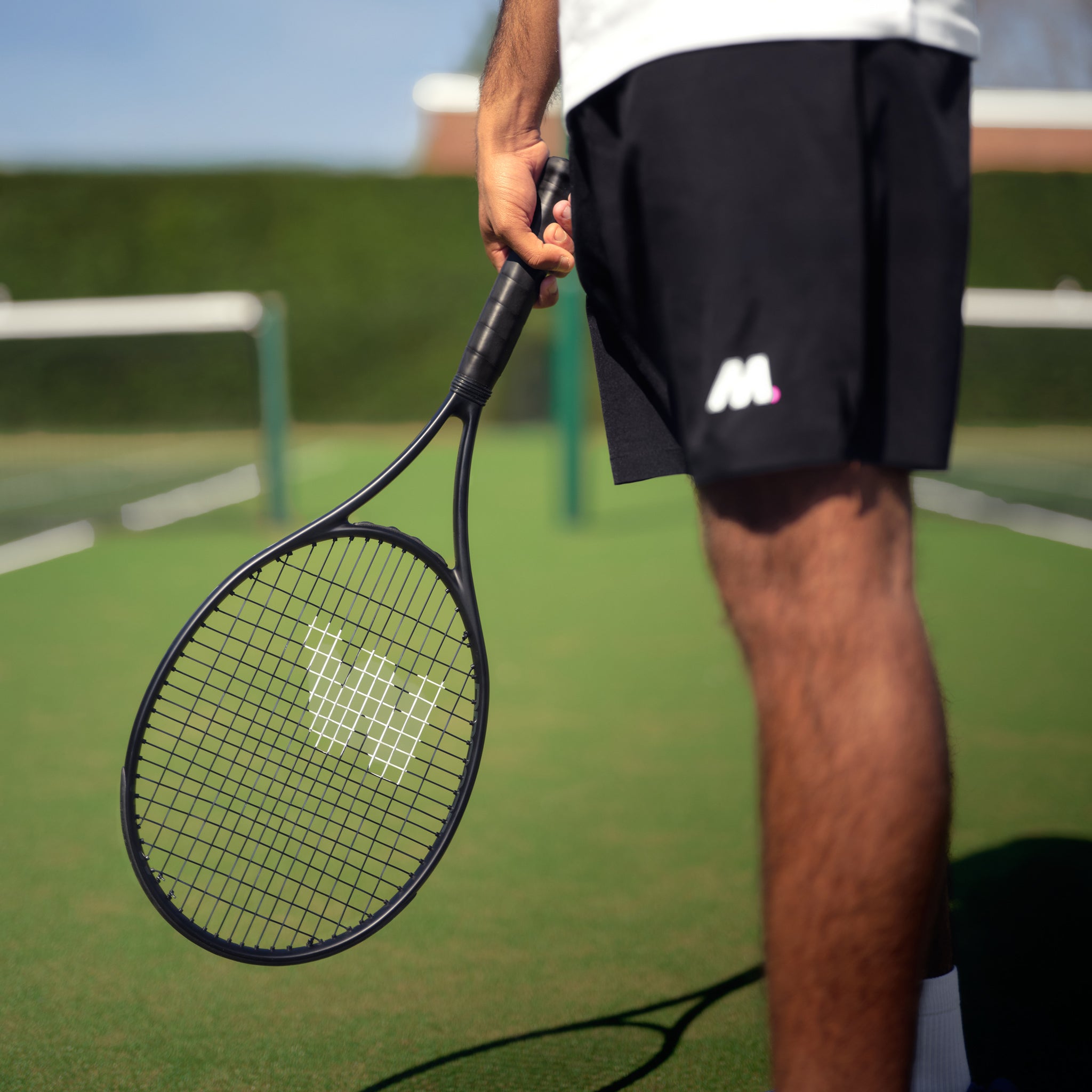
Of all the tweaks and upgrades you can make to your racket, a fresh grip is easily the most impactful for its cost. We’re not just talking about comfort here; your grip is the one direct connection you have to your racket, and it fundamentally changes your control, feel, and even your ability to stay injury-free. For more deep dives in addition to this feature on how to master your tennis grip, our detailed guide on how to grip a tennis racket is always here to help.
Master Your Tennis Grip: A Fresh Grip Is Your Best Upgrade
Let's be honest, a worn-out grip is more than just a bit shabby—it's a genuine liability to your game. Over time, that once-tacky surface becomes slick and smooth, and the cushioning gets compressed and hard. You find yourself clenching the handle just to keep the racket from twisting, which leads to fatigue and can be a fast track to problems like tennis elbow.
Here at Mantis, we think understanding why you should regularly change your grip is just as important as knowing how. A new grip instantly brings back that secure connection between your hand and the frame, giving you a much better feel for the ball and the confidence to hit your shots with purpose.
Gaining Superior Racket Control
The biggest and most immediate benefit you'll feel is the return of tackiness. That slight stickiness is what stops the racket from slipping or twisting in your hand on impact, which is crucial during a big serve or an off-centre hit.
When your racket feels secure, you can relax your hand. This simple change has a massive ripple effect on your game:
- Enhanced Feel: A lighter hold on the racket sharpens your ability to feel the ball on the strings. This gives you far more nuanced control over spin and where you place your shots.
- Increased Power: With a relaxed arm and wrist, you can generate more racket head speed. It’s the key to unlocking more fluid, powerful strokes without having to muscle the ball.
- Reduced Unforced Errors: When you fully trust your grip, you stop making those tiny, anxious adjustments mid-swing that so often lead to frustrating mistakes.
A fresh, tacky grip is the foundation of confidence. It completely removes that subconscious worry about the racket slipping, freeing you up to focus 100% on your strategy and execution.
The Role of Shock Absorption
Beyond just control, a good replacement grip is your first line of defence against shock and vibration. Every time you strike the ball, a surprising amount of force travels from the strings, through the frame, and straight into your hand and arm. A new, well-cushioned grip acts as a vital buffer.
This focus on grip technology is something that has evolved alongside rackets themselves. Thinking back to the 1970s, players using wooden rackets in British tennis had very few options. But with the boom of composite rackets in the 1990s, the need for better customisation grew. Players and coaches began paying much more attention to grip size and replacement cycles to reduce injury risk, a trend that was accelerated by the popularity of overgrips. If you're interested in the history, tennishq.co.uk offers some great insights into the evolution of tennis grips.
Choosing the Right Grip for Your Game
Picking the right grip is a lot like choosing your racket—it’s a deeply personal decision. The best grip feels like a natural extension of your hand, giving you that perfect blend of comfort, security, and feel. At Mantis, we know every player is different, which is why we’ve got a whole range of options.
Before you get wrapping, the first step is knowing exactly what you need. From ultra-tacky grips that lock your hand in place to highly absorbent ones for players who sweat buckets, there’s a perfect match for you. Your playing style, the typical UK court conditions, and even your own body chemistry all play a part.
Once you’ve got the right grip in hand, our guide on how to grip a tennis racket will walk you through the rest.
Replacement Grips vs Overgrips
First things first, let's clear up a common point of confusion: the difference between a replacement grip and an overgrip.
A replacement grip is the main, foundational layer that’s applied directly to the bare handle of your racket. It’s thicker, providing the core cushioning and shock absorption that protects your arm.
An overgrip, on the other hand, is a much thinner layer that you wrap over the replacement grip. Its job is all about tackiness and sweat absorption. It’s designed to be replaced often—some players use a fresh one every few matches—while a full replacement grip change might only happen once or twice a year.
Material and Feel
The material of your grip has a huge impact on how your racket performs and feels in your hand.
- Synthetic Leather Grips: These give you a classic, firm feel with brilliant feedback. Many advanced players love this direct connection to the frame because it allows for more precise shot-making.
- Cushioned Synthetic Grips: If comfort is your priority, these grips have extra padding to soak up more shock. They’re a fantastic choice for players looking to reduce arm fatigue or those with sensitive hands.
Grip size is also a massive factor for both comfort and performance. According to the Lawn Tennis Association (LTA), the average grip size for men is typically 4 3/8 inches (Size 3), while for women it’s 4 1/4 inches (Size 2). Just remember that adding an overgrip will increase the handle size by about 1/16 of an inch, which can subtly change your feel and control.
For players who crave that brand-new tackiness before every big match, overgrips are the perfect solution. They let you restore that fresh-out-of-the-packet feel without the fuss of a full replacement.
Ultimately, choosing the right grip comes down to knowing what you need on the court and a bit of experimentation. To help you narrow it down, we’ve compared the most common grip types below.
Comparing Tennis Grip Characteristics
This table breaks down the key characteristics of the main grip types, helping you pinpoint the best option for your game.
| Grip Type | Primary Benefit | Ideal Player Profile | Feel and Texture |
|---|---|---|---|
| Tacky | Provides an extremely secure hold, preventing racket twisting. | Players who want maximum connection and control. | Sticky and slightly adhesive feel. |
| Absorbent | Manages moisture effectively, ideal for sweaty hands. | Players in humid UK conditions or during intense matches. | Soft, often with a dry or cloth-like texture. |
| Cushioned | Offers superior shock absorption and comfort. | Players concerned with arm strain or tennis elbow. | Plush, soft, and noticeably thicker. |
Whether you prioritise a vice-like hold, moisture management for those long three-setters, or just want to give your arm a bit of a break, there's a grip designed just for you. Don't be afraid to try a few different types to discover what truly elevates your game.
Preparing Your Racket for a Flawless Finish
A perfect grip application starts long before you even unwrap the new one. So many players rush this part, and the result is always the same: a lumpy, uncomfortable grip that starts to unravel after a few sessions. If you want a professional, uniform finish that feels great and actually lasts, you have to put in the prep work.
This all begins with getting the old, worn-out grip off cleanly. Whether it’s just a tired overgrip or the original replacement grip underneath, the mission is to leave the handle's pallet completely bare, without a sticky mess of old adhesive. Once it's prepped, you can find the perfect Mantis grip for your racket on our product pages.
Removing the Old Grip and Residue
First things first, find the finishing tape at the top of the handle and start unwrapping it. From there, carefully unpeel the old grip, working your way down toward the butt cap. If you're only swapping out an overgrip, this should be a pretty clean and simple job.
But if you’re doing a full tennis grip replacement, the original grip will almost certainly leave behind some stubborn adhesive on the pallet (the bare handle). This sticky residue is the absolute enemy of a smooth, professional-feeling new grip.
At Mantis, we can't stress this enough: the handle must be completely clean, dry, and smooth before you even think about applying the new grip. Any leftover gunk or grime will create bumps under the new layer, ruining the feel and compromising your control.
To get rid of that sticky residue, you’ve got a few solid options:
- Household Items: A cloth lightly dampened with rubbing alcohol often does the trick. You could also try a mild, citrus-based cleaner. Just apply a small amount and gently rub the sticky spots until the gunk dissolves.
- Specialised Cleaners: For really stubborn adhesive, you can find specific grip residue removers designed to be safe on racket handle materials.
- A Gentle Scrape: In some cases, you can use the back of a dinner knife or a plastic scraper to carefully lift the worst of it. The key word here is gentle—the last thing you want to do is scratch or damage the pallet.
The Final Inspection
Once you're confident all the old grip and adhesive are gone, give the handle a final wipe with a clean, dry cloth. Now, run your fingers over the entire surface of the pallet. Feel for any remaining bumps or tacky spots you might have missed.
The handle should now be pristine—a perfect blank canvas. This is the difference between a quick fix and a proper racket upgrade. This attention to detail is what guarantees your new grip will stick properly and lie flat, giving you that flawless finish every player deserves.
Right, with a clean and prepped handle, we get to the best part: applying the new grip. This is where the magic happens, transforming a bare handle into something that feels custom-made for your hand. It might look a bit fiddly, but with a little patience and the right technique, you'll get a professional finish every time.
At Mantis, we reckon learning to wrap your own grip is a skill that connects you more deeply with your gear. For more tips from the pros, have a look through our blog.
First thing's first. Unroll your new grip and find the tapered end—it's the pointy bit, usually with a small patch of adhesive on the back. Peel off the paper covering that sticky section and get ready to fix it to the racket's butt cap. This first anchor point is the foundation for the whole job.
Starting with a Secure Anchor
Getting this initial step right is crucial. It stops the grip from twisting or bunching up when you’re in the middle of a tough rally. Press the adhesive end of the grip firmly onto one of the bevels of the butt cap, making sure it sits flush against the bottom edge.
Now for a detail that makes all the difference between an amateur job and a pro one: the wrapping direction. It all depends on whether you're right- or left-handed.
- For right-handed players: Wrap the grip clockwise (looking down from the butt cap).
- For left-handed players: Wrap it anti-clockwise.
Why does this matter? This simple trick ensures the natural twist of your hand during a forehand actually tightens the grip's seams, rather than loosening them and causing the grip to unravel. It’s a tiny detail that has a huge impact on how long your new grip will last.
Maintaining Tension and Overlap
Once your grip is anchored, start winding it up the handle. The real key here is to maintain consistent tension. You want to pull the grip taut—not so hard that you stretch it out of shape, but firmly enough that it lies perfectly flat against the handle with no air bubbles or slack.
As you wrap, you'll need to overlap each rotation slightly. The sweet spot is an overlap of about 1.5mm to 2mm (or roughly 1/16th of an inch). This creates a smooth, continuous surface with very subtle ridges, which a lot of players find improves their feel and control. Keeping this overlap consistent all the way up is what gives you that clean, uniform look.
A consistent, slight overlap is the secret to a comfortable and durable grip. Too much overlap creates bulky, pronounced ridges, while too little leaves gaps, exposing the hard pallet underneath and creating weak points.
This image breaks down the core stages into three key actions.

Seeing the process laid out like this really shows how a solid anchor, consistent wrapping, and a clean finish all come together to produce a result you can be proud of.
Finishing for a Clean Look
Keep wrapping with that steady tension and even overlap until you reach the top of the handle, just below the throat of the racket. As you get to the end, you’ll want the wrap to finish on a diagonal line.
Grab your scissors and trim the excess grip material, following that same diagonal angle. This little cut is what allows the end of the grip to lay flat and finish in a perfectly straight line around the handle.
The final touch is to secure your handiwork. Every new Mantis grip comes with a piece of branded finishing tape. Just peel off the backing and wrap it tightly over the top edge of the new grip. A good rule of thumb is to have half the tape on the grip and the other half on the racket frame itself. This seals everything in place and stops it from unravelling.
And that's it. Your tennis grip replacement is complete, looking and feeling like it was done by a stringer.
Right then, you’ve done the hard work and your racket is sporting a flawless new grip. The next step? Making sure it stays that way. All that effort you put into the perfect tennis grip replacement will pay off, but only if you take a few simple steps to maintain that fresh, tacky feel. At Mantis, we know that how you care for your grip after a match is just as important as how you wrapped it in the first place.
The biggest enemy of any new grip is moisture. It’s the fastest way to kill its surface and cushioning. A classic mistake we see all the time is finishing a tough match and immediately zipping the racket away in a damp bag. This turns your bag into a breeding ground for mildew and bacteria, which not only makes the grip feel slick and smell unpleasant but also breaks down the materials over time.
Get into this simple habit: always air out your racket after playing. Just let it sit out of your bag for a few hours. This allows sweat and any ambient moisture to evaporate completely, preserving the grip's natural tackiness and making it last so much longer.
Knowing When to Make a Change
Even with the best care in the world, no grip lasts forever. Knowing when it’s time for a change is crucial for keeping your performance consistent. How often you need to replace it really depends on how often you play, how much you sweat, and whether you use an overgrip.
For players who use overgrips, the signs are pretty easy to spot:
- Visible Wear: Look for thinning patches, frayed edges, or places where the colour has faded.
- Loss of Tackiness: If the surface feels smooth or slippery to the touch, its gripping days are over.
- Reduced Absorption: When the grip stops managing sweat effectively and your hand starts to slip, it’s time for a new one.
Proactive grip maintenance isn't just about comfort; it's about performance and hygiene. A worn grip can force you to clench the handle harder, leading to fatigue and increasing the risk of blisters.
Real-World Replacement Benchmarks
Looking at player habits here in the UK gives us some clear patterns. For both hygiene and performance, regular replacement is vital, as grips inevitably absorb sweat and dirt. Surveys show that around 70% of regular players in England replace their overgrip every 5-10 hours of play. This lines up with expert advice, as even competitive club-level players understand the need for a secure connection to their racket.
Among the most competitive players in the UK, it’s a different story. Up to 30% will even change grips mid-match due to sweat—a practice you see at the professional level, too. For more information about the professional side of tennis visit our partner Racket Business.
By adopting these simple maintenance habits and learning to spot the signs of wear, you can ensure your racket is always an asset, not a liability. It’s this kind of proactive approach that means your gear will be ready for your next big match, whenever it comes.
Got Questions About Your Grip? We’ve Got Answers
Even with the best guide in hand, a few questions always seem to pop up when you’re mid-wrap. Here at Mantis, we get queries all the time from players just like you, looking to get their grip replacement just right. So, we've put together the most common ones we hear.
These are the quick, clear answers to help you fix common hiccups and get a finish you can be proud of. Think of it as having an expert on standby.
(By the way, if your questions are about sizing, our detailed guide on how to find the right tennis racket grip size will walk you through measuring your hand and picking the perfect fit.)
How Often Should I Be Replacing My Grip?
This is the big one, and the honest answer is: it depends entirely on how much you play.
For overgrips, a great rule of thumb is to change them as many times per month as you play per week. So, if you're on court four times a week, you should be putting on a fresh overgrip four times a month. This keeps your connection to the racket feeling tacky and your sweat absorption at its peak.
Your main replacement grip, on the other hand, is a much tougher beast. You should only need to swap it out once or twice a year. The classic tell-tale signs are when the material starts to feel hard and compressed, looks visibly worn down, or has become unpleasantly slick.
Right-Handed vs. Left-Handed Wrapping: Does It Matter?
Yes, it absolutely matters! Getting this wrong is one of the most common reasons a new grip starts to unravel after just a few hits. The direction you wrap ensures the natural twisting motion of your swing actually tightens the grip’s seams, rather than loosening them.
It's a simple rule to remember:
- Right-handed players: Wrap in a clockwise direction (looking down from the butt cap).
- Left-handed players: Wrap in a counter-clockwise direction.
It’s a tiny detail, but it makes a massive difference to how long your new grip will last and how well it performs.
Help! How Do I Deal With Bubbles and Wrinkles?
Seeing those dreaded bubbles or wrinkles appear as you wrap is frustrating, but it almost always comes down to one thing: inconsistent tension. If you pull too loosely, the material creates slack that bunches up. Pull too tight in some spots and not others, and it stretches unevenly.
The secret to a smooth, pro-level finish is maintaining a firm, steady pull on the grip. Start at the butt cap and keep that same consistent pressure all the way up until you snip and secure it.
If you spot a bubble forming, don't panic. Just unwind a few inches and re-apply it with that steady, even pull. You're aiming to lay the grip perfectly flat against the handle’s bevels. It might take a bit of practice to get the feel for it, but soon enough, it’ll become second nature.
At Mantis, we believe that every detail of your equipment matters. From rackets to grips, our products are engineered with purpose for players who are serious about their game. Explore our full range of high-performance tennis gear at https://mantissport.com.








